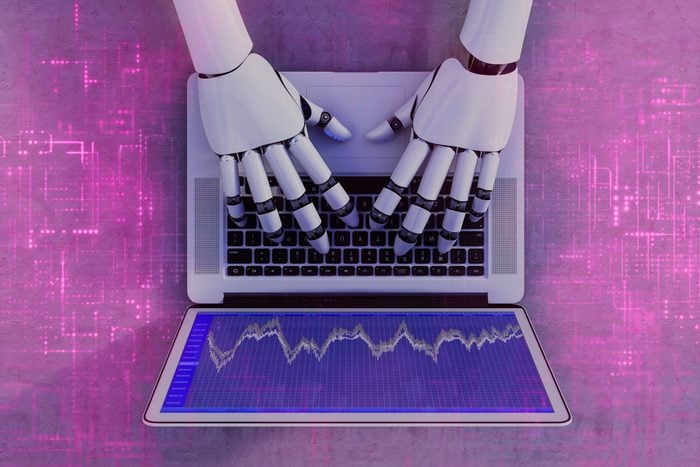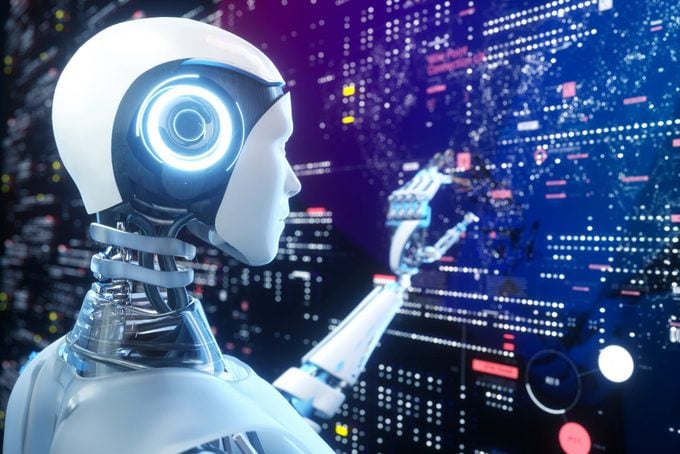Will Robots Take Your Job? How Artificial Intelligence Will Change the Future of Work
Updated: Nov. 23, 2023

Artificial intelligence is already affecting nearly every workplace in the country. Here's how the future of AI may shape the workplace of tomorrow.
When most people think of artificial intelligence (AI), they think of smarty-pants robots that can service our every whim. While real robots may be in the cards, the future of AI will also revolutionize the way we work (in real life and in the metaverse). In fact, AI is already in your workplace: You use AI when you use Google Maps to find your way to an off-site meeting (perhaps in a self-driving car?), or when you use spell-check for a report.
The current state of AI and the future of AI goes far beyond simplifying mundane tasks, however. Artificial intelligence, or computers that are taught to “think” like humans, can make us healthier, less stressed and happier through advancements in medicine, manufacturing and more. It’s not without its downsides, though. So let’s take a look at what the future of AI holds for the workplace, including some drawbacks and benefits you might see in your lifetime.
Examples of AI in the workplace today
Artificial intelligence is all around you. Applying for a job? There’s a good chance AI is screening resumes before they reach a human. Use a voice assistant on your phone to help you with workplace tasks? Alexa, Google Assistant and Siri all use AI to answer your questions and perform functions.
When you use Google or another search engine to look up information, you’re using AI. When your company car prevents you from swerving off the road when you’re drowsy, it uses AI.
Manufacturers use AI to find simpler and more affordable ways to produce better-quality products. AI can also review the history of manufacturing equipment to determine the best times to maintain the machinery.
In the medical industry, AI can find tumors with a better success rate than radiologists. It can also diagnose other illnesses and determine the best way to proceed with medical trials.
And though Web3, the next evolution of the internet, is in its infancy, we can already see how it and AI may combine for a work experience unlike today’s norm. Some companies are already starting to hold meetings in the metaverse, and experts expect that to occur more often in the future.
The future of AI in the workplace
Whenever humans consider the future of AI, it’s with one big question in mind: Will robots take my job? Most experts agree that humans will still be a necessary part of the workforce, at least for a very long time.
“As more and more of the mundane tasks people are forced to do in the name of productivity become intelligently automated using AI, people will be free to do what we all do best and what makes us happiest: creative problem-solving,” says Robb Wilson, an AI researcher and author of Age of Invisible Machines. “This will require a major shift in our thinking about what has value in the world and how we obtain our basic needs.”
Wilson explains that while it’s true that some jobs will disappear, new ones that involve working specifically with AI will arise. The biggest shift may be in what we get out of work, a change akin to the reshaping of labor in the wake of the Industrial Revolution. Many jobs will become more rewarding as people perform their work alongside AI, solving problems in new and exciting ways.
“So much of culture in the modern age is built around the idea of putting in 40 hours at work, regardless of whether those hours spent tied to a place, a desk or a role are actually necessary,” says Wilson. Companies of the future may finally part with the idea of a 40-hour workweek.
“With technology as a partner, we should be able to live in a world where everyone’s job is some version of contributing creatively to solving the many problems that surround us,” he says. “There are undoubtedly ways in which technology can help us create and manage a surplus of resources [like food, water, shelter and medicine] in ways that might make the 40-hour workweek irrelevant. That can be either a scary idea or a liberating one, depending on how you view the world.”
What industries will AI change?
AI has already changed almost every industry, but the future of AI promises to revolutionize even more businesses.
- Health care: With artificial intelligence, doctors will be able to better diagnose illnesses, making lifesaving early treatment more likely. They might use AI to create new ways to treat illnesses like dementia and cancer, and they could use it to predict future illnesses, combining a patient’s health history and genetic data to create a preventative care plan.
- Service industry: In the future, robots and machines run by AI could replace customer service representatives, cashiers and even cooks. Robots are already manning fry baskets and the like at fast-food restaurants.
- Law enforcement: Some day soon, AI facial recognition in security cameras could help police officers catch potential criminals. Intelligent bots could even replace police officers. AI-run robots are already used as security officers in some businesses.
- Online security: AI is already in development to more intelligently detect online fraud and protect consumers. The AI will be able to detect changes in spending and credit activity better than the (often wrong) activity alerts that we currently get.
- Transportation: Say goodbye to taxi and Lyft drivers. In the future, cars will be able to drive themselves (some already do). We may also see automated trains and airplanes.
- Marketing: AI already targets you with customized ads on social media sites, but soon it may even be able to create the ads you see or articles you read. There are already article and ad-writing bots that developers claim are almost as good as a human creator.
Pros of AI in the workplace

There are many benefits of artificial intelligence, but the big plus to using AI in the workplace is that it does repetitive and mundane tasks that no one really wants to do. This can make work for humans easier, making us more productive with less effort. For example, AI can input data into spreadsheets, help online customers return purchases or fill out forms.
“From a business perspective, AI can be the difference between getting ahead or falling behind in any given market,” says Lou Bachenheimer, PhD, chief technology officer of the Americas with SS&C Blue Prism, a global leader in intelligent automation. “When used alongside appropriate technologies, such as intelligent automation, AI has the ability to improve customer experience significantly, adapt to rapidly changing market conditions, bring new products and services into effect quicker and more efficiently, boost competitiveness and create a better working environment for its employees.”
And there’s a silver lining to the effect AI will have on the job market. As AI expands, many jobs, like customer service positions, may disappear. But the greater existence of AI in our lives will open up future technologies and careers that don’t currently exist. According to the World Economic Forum, AI will displace 85 million jobs but create 97 million new jobs across 26 countries by 2025.
And these may be better-paying jobs than the ones lost through the adoption of artificial intelligence. After all, we’ll need people to build, maintain and work with AI. The only catch is that these new jobs will often require advanced training. This may be harder to attain for some, due to the cost of advanced degrees, disabilities and other issues.
Cons of AI in the workplace
While the future of AI has a lot of positives, there are some negatives. AI bias, environmental impacts and machines’ lack of emotional intelligence are all kinks in the system.
AI bias
Humans have biases, and they can pass them on to the AI they program. AI can even inadvertently learn biases from sets of data. This can be particularly harmful when companies use AI in the job recruitment field. And that’s not a problem for the far-flung future.
Plenty of companies today use AI to sort through job applications, but a program could potentially toss out resumes that go against its bias. For example, Amazon had to stop using AI to review applications after it developed a bias against women applicants. Since most of the applicants were men, the AI determined that men were the best candidates for the job.
AI bias is such a real and present concern that lawmakers have introduced a bill (the Algorithmic Accountability Act of 2019) to hold companies accountable for the AI systems they use.
Environmental impact
Another problem with the future of artificial intelligence is that computing and processing power can be prohibitive to adoption and can harm the environment. Just as, say, NFTs are bad for the environment because their purchase and transfer use a lot of computing power, AI training requires powerful computers.
To train an AI, these computers (called graphics processing units, or GPUs) use massive amounts of energy, sometimes for months at a time. One training that teaches an AI to understand human language creates 626,155 pounds of carbon dioxide emissions over 3.5 days. That has about the same environmental impact as five cars.
Much of the environmental impact comes down to the advancement in deep learning, a type of machine learning that uses artificial neural networks to help the machine think like a human. It’s the brain behind self-driving cars, for instance.
“Oceans of cash are being flung at AI developers right now in a Gold Rush–era mania to establish first mover advantages,” said Peter Scott, author of Artificial Intelligence and You and founder of Next Wave Institute, an international educational organization teaching how to understand and leverage AI. “A lot of this funding is, uncreatively, being directed at merely increasing the size of deep learning models, which double in size every 3.4 months currently and, as a result, are projected to soon use a significant fraction of the world’s electricity. This is because deep learning has demonstrated amazingly powerful results, and many people anticipate that all it takes to get even more powerful results is to make it bigger.”
Lack of emotional intelligence
Machines are great at processing transactions quickly and accurately, but they fall short in many areas that require complex thoughts or emotions, Bachenheimer points out. They just don’t have the emotional intelligence that humans do.
Take chatbots as an example. In most cases, they are unable to provide a good experience for the user because they are not able to use emotional intelligence to provide a better customer service experience. They tend to fall short in situations where a human touch is needed or the solution to the problem is complex and requires creativity.
Case in point: mental health chatbots. When BBC reporters tried to gauge their usefulness for treating serious conditions, they found the chatbots failed to recognize sexual abuse. “These building blocks [of support] grow through relationships between human beings,” write the authors of a 2021 study published in the journal SSM Mental Health. “AI is inherently limited in its ability to relate to a human through its own internal experience.”
In short, while future robots may take over for humans when it comes to doing dangerous tasks, they’re probably not going to be the therapist you turn to when times are tough.
The future of AI
While AI does have its drawbacks, there’s nothing stopping it from forging ahead. Experts stress that as AI evolves, humans need to be careful to monitor and regulate its progress to keep it as ethical and as environmentally friendly as possible.
If thinking about the future of AI has you imagining other ways life may change in the years to come, read more of our coverage of the future of tech, including how real estate works in the metaverse, what to expect from the future of virtual reality and everything you need to know about NFTs.
Sources:
- Robb Wilson, AI researcher, founder of OneReach.ai and author of Age of Invisible Machines
- Lou Bachenheimer, PhD, chief technology officer of the Americas with SS&C Blue Prism
- Peter Scott, founder of Next Wave Institute and author of Artificial Intelligence and You
- Future Healthcare Journal: “The Potential for Artificial Intelligence in Healthcare”
- National Institute of Standards and Technology: “There’s More to AI Bias Than Biased Data, NIST Report Highlights”
- World Economic Forum: “Don’t fear AI. It will lead to long-term job growth.”
- Santa Clara University: “AI and the Ethics of Energy Efficiency”
- MIT Work of the Future: “Artificial Intelligence and the Future of Work”
- American University: “AI and the Future of Work in the United States”
- Reuters: “Amazon scraps secret AI recruiting tool that showed bias against women”
- BBC: “Child advice chatbots fail to spot sexual abuse”
- SSM Mental Health: “AI chatbots cannot replace human interactions in the pursuit of more inclusive mental healthcare”
- U.S. Senate: “Algorithmic Accountability Act of 2019”



